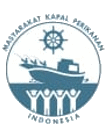AKTIVITAS INHIBITOR TIROSINASERUMPUT LAUT Halimeda Spp DARI PESISIR ACEH BARAT
Abstract
Full Text:
PDFReferences
Batubara I, Darusman LK, Mitsunaga T, Rahmiwati M, Djauhari E. 2010. Potency of Indonesian Medicinal Plants a Tyrosinase Inhibitor and Antioxidant Agent. J Biol Scie 10: 138-144.
Beissert S. 2002. Use of mutant mice in photoimmunological and photocarcinogenetic investigation. Methods 28 : 130–137.
Booij K, Hillebrand TJ, van Ooijen J. 2001.Nutrien, trace metal and organiccontaminant in Banten bay, Indonesia.Marine Pollution Bulletin. 42(11): 1187-1190.
Cabanes JS, Chazarra, Carmona FG. 1994. Kojic acid, a cosmetic skin whitening agent is a slow-binding inhibitor of catecholase activity of tyrosinase. J. Pharm. Pharmacol. 46 : 928 - 985.
Curto EV, Kwong C, Hermersdosfer H, Glatt H, Santis C. 1999. Inhibitor of mammalian melanocyte tyrosinase: in vitro comparisons of alkyl esters of gentisic acid with other putative inhibitor. Biochem Pharm 57: 663-672.
[DPT] Ditjen Perikanan Tangkap. 2015.Indonesia produsen rumput laut cottoniiterbesar dunia. http://kkp.go.id. Diaksespada tanggal 5 Oktober 2018 pada pukul12.00 WIB.
Farhan AR, Lim S. 2012. Vulnerabilityassessment of ecological condition inseribu island, Indonesia. Ocean andCoastal Management. (65) : 1-14
Fitrie, A.A., 2004, Histologi dari melanosit. e-USURepository Universitas Sumatera Utara 5:1-6.
Friedmann PS, Gilcrest BA. 1987. Ultraviolet radiation directly induces pigment production by cultured human melanocytes. J. CellPhysiol. 133: 88-94.
Gilchrest BA, Park HY, Eller MS, Yaar M. 1996. Mechanisms of ultraviolet light-induced pigmentation. Photochem and Photobiol. 63(1): 1-1 0.
Ha YM, Chun SW, Song S, Lee H, Suh H, Chung HY. 2007. 4-(6-Hydroxy-2-naphthyl)-1,3-bezendiol: A potent, new tyrosinase inhibitor. Biol. Pharm. Bull. 30 (9) : 1711-1715.
Harborne JB. 1984. Phytochemical Method: A guide to modern techhniques of plant analysis. Second edition. Chapman and Hall. New York.
Hartanti, L., Setiawan, H.K., 2009, Inhibitorypotential of some synthetic cinnamic acidderivatives towards tyrosinase enzyme, IndoJ Chem 9:158-168
Hunt G, Todd C, Cresswell JE, Thody AJ. 1994. α-Melanocyte stimulating hormone and its analogue Nle4DPhe7α-MSH affect morphology, tyrosinase activity and melanogenesis in cultured human melanocytes. J.Cell. Sci. 107 : 205-211.
Kim, Y.-J.; Uyama, H. 2005. Tyrosinase inhibitors from natural and synthetic sources: Structure,inhibition mechanism and perspective for the future. Cell. Mol. Life Sci., 62, 1707–1723.
Libow LF, Scheide S, De Leo VA. 1988. Ultraviolet radiation acts as an independent mitogen for normal human melanocytes in culture. Pig. Cell Res 1: 397-401.
Likhitwitayawuid K. 2008. Stillbenes with tyrosinase inhibitory activity. J CurrSci. 94:44-52.
Lin JW, Chiang HM, Lin YC, Wen KC. 2008. Natural products with skin-whitening effects. J. Food and Drugs Analysis. (16). 2: 1-10.
Miyazawa, M, Tamura, N., 2007, Inhibitorycompound of tyrosinase activity from the
sprout of Polygonum hydropiper L.(Benitade), Biol Pharm Bull 30:595-597.
Montgomery, R., Conway, T.W., Spector, A.A.,1993, Biokimia Berorientasi pada KasusKlinik, Staf Pengajar FKUI, penerjemah;Jakarta: Binarupa Aksara.
Nerya O, Musa R, Khatib S, Tamir S, Vaya J. 2004. Chalcones as potenttyrosinase inhibitors: the effect of hydroxyl position sand numbers.Phytochemistry 65: 1389-1395.
Pandel R, Polsaj B, Godic A, Dahmane R. 2013. Skin photoaging and the role of antioxidants in its prevention. Dermatology. 1-11.
Pawelek JM, Korner AM. 1982. The biosynthesis of mammalian melanin. Am Sci.
:136-145
Prota G, Thomson RH. 1976. Melanin pigmentation in mammals. Endeavor:35: 32-38.
Sanchez-Ferrer A, Rodrygez-Lopez JN, Garcya-Carmona F. 1995. Tyrosinase: Acomprehensive review of its mechanism. Biochim Biophys Acta. 1247:1-11.
Slowminski A, Desmond JT, Shibahara S, Wortsman J. 2004. Melanin pigmentation in mammalian skin and its hormonal regulation. Physiol. Rev. 84 : 1155 – 1228
Spritz RA, Hearing VJ. 1994. Genetic disorder dipigmentation. Adv. Hum. Genet.22 : 1- 45.
Yamauchi K, Mitsunaga T, Batubara I. 2011. Isolation, identification andtyrosinase inhibitory activities of the extractives from Allamanda cathartica.J Natural Resources 2:167-172.
DOI: https://doi.org/10.35308/jpt.v5i2.1034
Refbacks
- There are currently no refbacks.
Copyright (c) 2019 JURNAL PERIKANAN TROPIS
Jurnal Perikanan Tropis (print ISSN 2355-5564 ;online ISSN 2355-5572), is published by the Faculty of Fisheries and Marine Science Universitas Teuku Umar, Indonesia .

This work is licensed under a Creative Commons Attribution-NonCommercial-ShareAlike 4.0 International License










